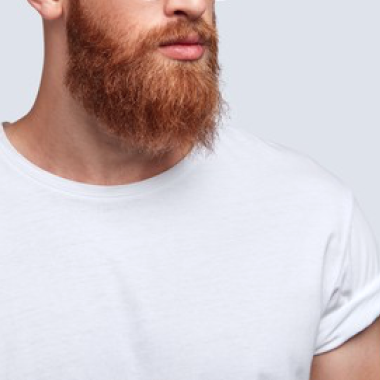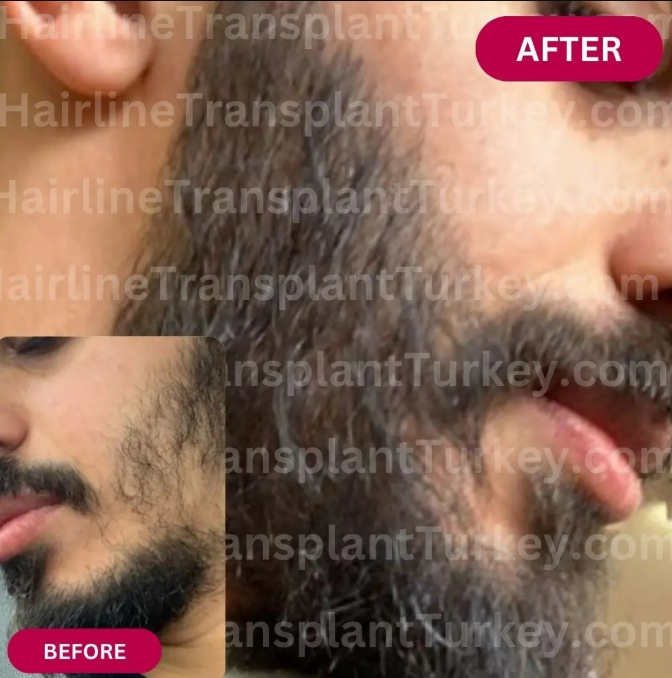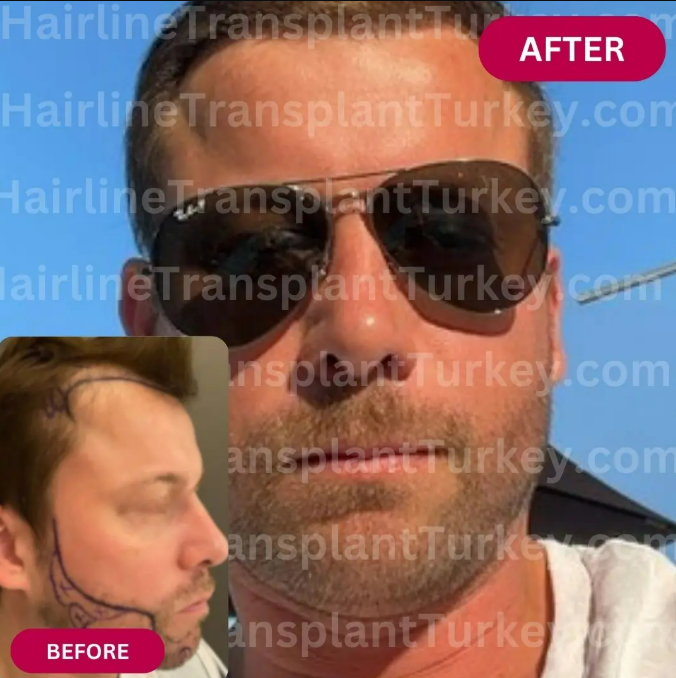Facial hair transplant, or a beard transplant, is a surgical procedure that involves the transplantation of hair follicles to the facial area to achieve a fuller and more aesthetically pleasing beard, mustache, or sideburns.
Book a Free Consultation
Find A Facial Hair Transplant Clinic That Suits Your Needs
Facial hair has long been associated with masculinity, confidence, and attractiveness. However, not everyone is blessed with a full and well-defined beard or mustache. This is where facial hair transplant comes into play, offering a solution for those who desire a more robust facial hair growth.
The demand for facial hair transplant procedures has witnessed a significant surge in recent years. This surge can be attributed to several factors, including the increasing acceptance and popularity of beards and mustaches as fashionable trends, the influence of media and celebrity culture, and the accessibility of advanced surgical techniques.

Tom, Lead Clinic
Researcher and Writer
The growing demand for facial hair transplants has led to a surge in specialized clinics and experienced surgeons offering these procedures. It can be a daunting task to find the best clinic. For more than ten years, I have been evaluating hair transplant clinics in Turkey. I am delighted to assist you in discovering a clinic that matches your requirements.
The history of facial hair transplantation can be traced back to the early 20th century when Dr. Okuda, a Japanese dermatologist, first performed a hair transplant procedure on the eyebrows of burn victims.
Advancements in surgical techniques, such as follicular unit extraction (FUE) and Direct Hair Implantation (DHI), have revolutionized the field of facial hair transplant. These techniques have made the procedure more precise, minimally invasive, and with significantly reduced recovery time.
What is a Facial Hair Transplant?
A facial hair transplant is a cosmetic procedure designed to enhance or restore facial hair growth in areas where it is sparse, thin, or absent. This procedure is commonly sought by individuals who have difficulty growing facial hair, whether due to genetics, scarring, medical conditions, or other factors. The primary goal of a facial hair transplant is to create a more full and aesthetically pleasing beard, mustache, or sideburns.
The procedure involves the transplantation of hair follicles from one part of the body, typically the back of the scalp, to the recipient area on the face. This donor area is chosen because the hair in that region is often similar in texture and quality to facial hair.
The duration of a facial hair transplant procedure can vary depending on the individual’s specific needs and the extent of the transplantation. On average, the procedure can take anywhere from 4 to 8 hours to complete.

Tom, Lead Clinic
Researcher and Writer
Curious about what to expect after your facial hair transplant? Dive into my blog post about beard transplant recovery for insights on a seamless journey.
I’m here to assist you. Reach out to me for personalized guidance and embark on your journey to impeccable facial hair.


Facial Hair Transplant Methods
Facial hair transplant is a surgical procedure that involves the transplantation of hair follicles from the donor area to the recipient area on the face. This procedure is commonly performed to enhance the growth of facial hair, such as beards and mustaches, in individuals who have thin or patchy facial hair.
There are two main extraction methods used in facial hair transplant:
Follicular Unit Extraction (FUE)
+ Minimal scarring
+ Natural-looking results
– Time-consuming
– Limited donor area
A FUE hair transplant involves the extraction of individual hair follicles from the donor area using a small punch tool. FUE is preferred for facial hair transplant as it allows for precise extraction and minimal scarring. The extracted follicles are then carefully implanted into the recipient area.
Direct Hair Implantation (DHI)
+ Precise placement
+ Minimal scarring
– Time-consuming
– Limited number of grafts
The DHI hair transplant technique involves the use of a specialized tool called a Choi implanter pen, which allows for the direct implantation of hair follicles into the recipient area without the need for creating incisions beforehand. DHI offers greater control over the angle and direction of hair growth, resulting in a more natural-looking outcome.
Am I a Candidate For a Facial Hair Transplant?
Before undergoing a facial hair transplant, several factors need to be considered to determine the eligibility of you as a patient.
- Evaluation of donor area and hair density
The donor area, typically the back of the head, is assessed to ensure an adequate supply of healthy hair follicles. The density and quality of hair in the donor area play a crucial role in determining the success of the transplant. A thorough evaluation is conducted to determine the number of grafts that can be safely extracted without compromising the donor area’s appearance.
- Assessing patient’s expectations and motivations
Understanding your expectations and motivations for undergoing a facial hair transplant is essential. It is crucial to have a clear understanding of the desired outcome and whether it aligns with the your natural hair growth pattern. Realistic expectations are vital to ensure patient satisfaction and avoid potential disappointment.
Pre-operative Preparations Before a Facial Hair Transplant
Proper pre-operative preparations are crucial to ensure a successful facial hair transplant procedure.
Medical evaluation and consultation
Before undergoing the procedure, a comprehensive medical evaluation is conducted to assess the patient’s overall health and determine their suitability for surgery. This evaluation includes a review of medical history, physical examination, and possibly some laboratory tests. Additionally, a consultation with the surgeon is essential to discuss the patient’s goals, expectations, and any concerns they may have.
Shaving and preparation of the recipient and donor areas
Prior to the procedure, the recipient and donor areas are shaved to ensure optimal visibility and facilitate the transplantation process. Shaving also allows for a more accurate assessment of the donor area’s hair density and helps in planning the transplantation.
Discussion of desired beard or mustache style
During the pre-operative consultation, you and the surgeon discuss the desired beard or mustache style. This discussion includes factors such as the shape, density, and distribution of the facial hair. The surgeon provides guidance based on the yourfacial structure and natural hair growth pattern to achieve a harmonious and aesthetically pleasing result.
Preparing mentally and emotionally for the procedure
Undergoing any surgical procedure can be emotionally and mentally challenging. Patients are encouraged to prepare themselves mentally and emotionally for the facial hair transplant. This may involve understanding the recovery process, managing expectations, and addressing any concerns or anxieties they may have. Open communication with the surgeon and support from loved ones can also play a significant role in easing any apprehensions.
Understanding Hair Loss
Before you can truly commit to a hair transplant it is important to understand hair loss. Together with the experts at IdealofMeD, we wrote an e-book explaining everything you need to know about hair loss. From hair loss causes to practical tips on how to deal with hair loss and the best hair loss products.

Benefits and Risks of Facial Hair Transplant
Facial hair transplant offers numerous benefits. However, it is crucial to consider the potential complications associated with the procedure. By selecting a skilled surgeon and following proper care instructions, individuals can minimize these risks and achieve the desired long-term results.
Facial Hair Transplant Benefits
- Enhanced Facial Aesthetics and Symmetry
Facial hair plays a crucial role in defining a person’s appearance and can significantly enhance facial aesthetics and symmetry. A well-groomed beard or mustache can help balance facial features, providing a more harmonious and attractive overall look. Facial hair transplantation offers a solution for those who struggle with patchy or sparse facial hair, allowing them to achieve a fuller and more balanced facial appearance.
- Boost in Self-Confidence and Self-Esteem
For individuals who have struggled with facial hair growth, a successful facial hair transplant can be life-changing. The ability to grow a full beard or mustache can provide a significant boost in self-confidence and self-esteem. It allows individuals to feel more comfortable in their own skin and project a more confident image to the world.
- Ability to Grow a Full Beard or Mustache
One of the primary benefits of a facial hair transplant is the ability to grow a full beard or mustache. This is particularly valuable for individuals who have struggled with patchy or uneven facial hair growth due to genetics, scarring, or other factors. With advancements in hair transplantation techniques, skilled surgeons can artfully transplant hair follicles to create a natural and dense facial hair pattern, providing individuals with the opportunity to achieve the facial hair style they desire.
Facial Hair Transplant Risks
- Infection and Scarring
As with any surgical procedure, there is a risk of infection and scarring associated with facial hair transplantation. However, these risks can be minimized by choosing a reputable and experienced surgeon who follows strict sterilization protocols and uses advanced techniques. Proper post-operative care and adherence to the surgeon’s instructions can also significantly reduce the risk of complications.
- Temporary Swelling and Discomfort
Following a facial hair transplant, it is common to experience temporary swelling and discomfort in the treated area. This is a natural part of the healing process and typically subsides within a few days to a week. Surgeons may prescribe pain medication or recommend cold compresses to alleviate any discomfort during this period.
- Potential for Hair Follicle Damage or Failure
While facial hair transplantation has a high success rate, there is a small possibility of hair follicle damage or failure. Factors such as the patient’s individual healing process, the skill of the surgeon, and the quality of the transplanted hair follicles can influence the outcome. It is essential to choose a skilled and experienced surgeon who specializes in facial hair transplantation to minimize the risk of complications.

Tom, Lead Clinic
Researcher and Writer
If you need help finding the best clinic for your needs, feel free to contact me directly.
Just like a regular hair transplant, facial hair transplant requires extra care and expertise. You can read over 50 reviews of hair transplant clinics on our hair transplant Turkey reviews page to learn about the experience of the patients who have done beard or eyebrow transplants.
I also suggest you use the Hair Back App to communicate with others who have undergone facial hair transplants.
Calculate Cost & Get the Best Offers
Finding the Right Beard Transplant Surgeon
When it comes to undergoing a facial hair transplant, finding the right surgeon is of paramount importance. This section will delve into the various factors to consider and steps to take in order to ensure that you choose a qualified and experienced surgeon who can deliver the desired results.
Chose a qualified and experienced surgeon
Selecting a qualified and experienced surgeon is crucial for the success of your facial hair transplant. A skilled surgeon will have the necessary expertise and knowledge to perform the procedure safely and effectively. They will also be well-versed in the latest techniques and advancements in the field, ensuring that you receive the highest standard of care.
Moreover, an experienced surgeon will have a track record of successful facial hair transplant cases, which can provide you with the confidence and assurance that you are in capable hands. By choosing a qualified and experienced surgeon, you minimize the risks associated with the procedure and increase the likelihood of achieving natural-looking and aesthetically pleasing results.
Research and evaluate potential surgeons
To find the best surgeon for your facial hair transplant, thorough research and evaluation are essential. Consider the following factors when assessing potential surgeons:
- Credentials and certifications: Look for surgeons who are board-certified and have undergone specialized training in hair restoration. Certification from reputable organizations such as the American Board of Hair Restoration Surgery (ABHRS) or the International Society of Hair Restoration Surgery (ISHRS) demonstrates a surgeon’s commitment to maintaining high standards of practice.
- Portfolio of previous facial hair transplant cases: Reviewing a surgeon’s portfolio of previous facial hair transplant cases can provide valuable insight into their skills and expertise. Look for before and after photos of patients with similar hair loss patterns or desired outcomes to assess the surgeon’s ability to achieve the results you desire.
- Patient testimonials and reviews: Seek out patient testimonials and reviews to gain a better understanding of the surgeon’s reputation and patient satisfaction. Online platforms, such as reputable review websites or forums dedicated to hair restoration, can offer valuable feedback from real patients who have undergone similar procedures.
Facial Hair Transplant Experiences Video Playlist
2/10/2021
Our Skincare & Haircare: https://feelconfident.com
For Surgical Consultations: (347) 434-8397
328K Views • 4.1K Likes • 579 Comments
3/25/2021
In this episode, we discuss the topic of Beard Transplantation.
24K Views • 251 Likes • 53 Comments
4/15/2022
Jay’s beard transplant is now more than a year ago. In this video we present the full journey.
210K Views • 1.8K Likes • 218 Comments
1/4/2023
Case Doctor: @dr_firdavsahmedov
Beard: ✔ 2750 Grafts Transplanted
64K Views • 1.3K Likes • 53 Comments

Tom, Lead Clinic
Researcher and Writer
Confused about selecting the ideal facial hair transplant procedure? Your journey starts with a crucial first step: consulting with a reputable clinic. Begin by completing the form to secure a free consultation and receive offers from clinics renowned for delivering outstanding results.
The Facial Hair Transplant Procedure
Let’s have a closer look at a step-by-step breakdown of a typical facial transplant procedure.
- Anesthesia and sedation: The facial hair transplant procedure begins with the administration of local anesthesia to ensure patient comfort and minimize any potential discomfort during the surgery. Sedation may also be provided to help patients relax throughout the procedure.
- Donor area extraction: Once the patient is adequately anesthetized, the surgeon carefully selects the donor area from which hair follicles will be extracted. The most common donor area for facial hair transplantation is the back of the scalp, as it typically provides a good match in terms of hair texture and thickness.Using a specialized punch tool, the surgeon gently extracts individual hair follicles or small groups of follicles, known as grafts, from the donor area. This extraction process is meticulously performed to ensure minimal damage to the surrounding hair and to maximize the survival rate of the grafts.
- Preparation and implantation of grafts: After the donor hair follicles are extracted, the surgeon meticulously prepares the recipient area on the face where the grafts will be implanted. This involves creating tiny incisions or slits in the skin, following the natural direction and angle of the existing facial hair.The extracted hair follicles are then carefully placed into the prepared incisions, ensuring that they are positioned at the correct angle and depth to achieve a natural-looking result. The surgeon’s expertise in graft placement is crucial to ensure proper density and distribution of the transplanted hair.
- Post-operative care and instructions: Following the facial hair transplant procedure, the patient will be provided with detailed post-operative care instructions. These instructions typically include guidelines on how to keep the transplanted area clean, avoid excessive touching or scratching, and manage any potential discomfort or swelling.
It is important for patients to follow these instructions diligently to promote proper healing and minimize the risk of complications. Additionally, the surgeon may prescribe medication, such as antibiotics or pain relievers, to aid in the recovery process.

Tom, Lead Clinic
Researcher and Writer
Complete the form, and I will assist you in obtaining offers from top hair transplant clinics in Turkey. I will ensure that they possess ample experience with facial hair transplants and can provide you with a reasonable price. Click the button below to get the best offers and read more about beard transplant cost in Turkey in my guide.
Facial Hair Transplant Cost
The cost of a facial hair transplant can vary widely due to several influencing factors. Geographical Location plays a significant role, as the cost of medical procedures varies across different regions.
Clinic Reputation and Expertise are other important considerations. Established clinics with experienced surgeons and a history of successful procedures might charge more due to their renowned expertise.
The Extent of the Procedure, including the desired amount of facial hair, can notably impact the overall cost. A comprehensive full beard transplant typically incurs a higher cost compared to addressing specific patchy areas. The type of technique used is a factor, with options like Follicular Unit Extraction (FUE) and Follicular Unit Transplantation (FUT). FUE, involving the intricate individual extraction and transplantation of follicles, tends to be pricier due to its complexity.
The Number of Grafts Required directly influences the cost. More grafts (hair follicles) needed for the procedure correlate with higher overall expenses.
Your Questions
Answered
Yes, facial hair transplants use your own hair follicles, which are typically resistant to balding, making the results generally permanent. However, it’s important to note that the transplanted hair may undergo a shedding phase before new hair growth begins, and individual results can vary.
Yes, after the procedure, it’s important to follow your surgeon’s instructions, which may include gentle cleansing, avoiding sun exposure, refraining from strenuous activities, and proper post-operative wound care to ensure optimal healing.
The recovery process after a facial hair transplant can vary, but most patients can expect to resume their normal activities within a week. Full results are usually noticeable around six to nine months after the procedure.
Absolutely. Skilled surgeons who have experience with different hair types, including curly and afro-textured hair, can perform successful facial hair transplants. Consulting with an experienced professional is crucial to ensure the best outcome. Read more in our full guide to afro hair transplant.

Tom, Lead Clinic
Researcher and Writer
Summary & Advice
I am Tom, and I have been working as a writer since 2014, assisting individuals seeking information about hair loss solutions. If you believe I can be of assistance, please don’t hesitate to get in touch.
Drawing from personal experience, I understand how a receding hairline can evoke feelings of anxiety. The sad truth is, many men are bound to lose their natural hairline as they grow older. It is just nature taking its course.
If not natural causes, accidents and medical procedures can lead to permanent hair loss. That doesn’t mean you have to settle for with the image of a balding person you see in the mirror.
I’m happy to help you find the best clinics in Turkey that offer effective and permanent solutions to facial hair loss.
